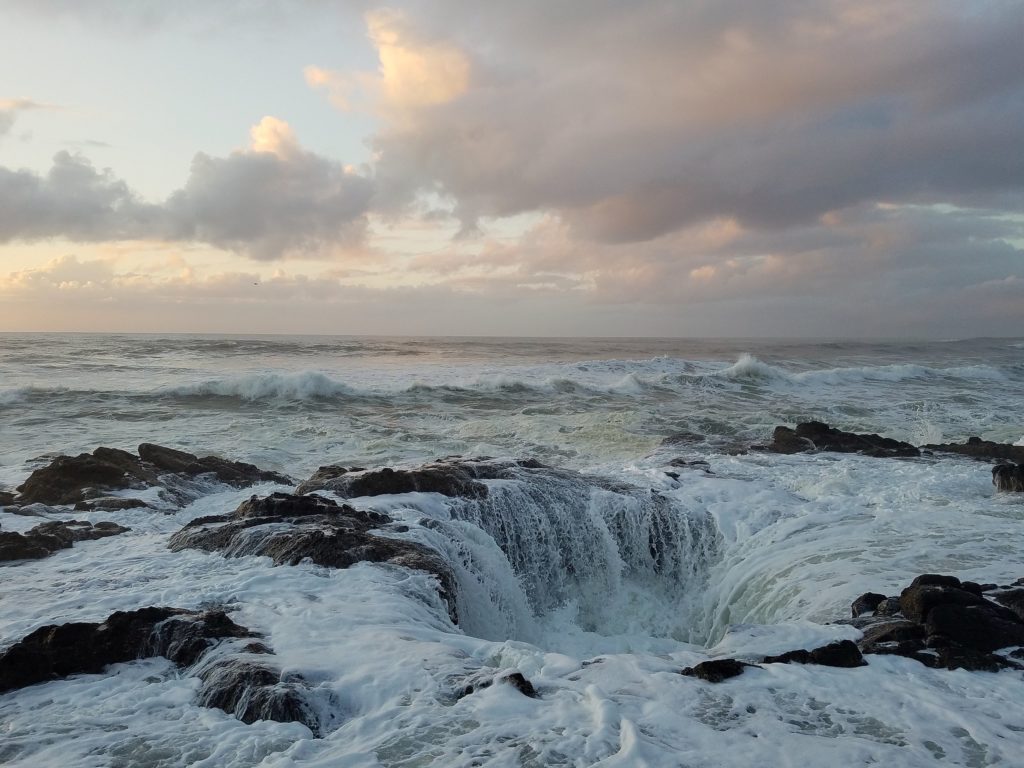Thor’s Well: Down the Pacific plughole
by Scott Dutfield · 12/11/2019

Image credit: John Fowler
What created Thor’s Well and where does all the water falling into it go?
Along a large, forested headland of Oregon, US, sits a sinkhole that appears to drain away the water of the Pacific Ocean. Named after the Norse god of thunder, Thor, the legend of the well says that in a fit of rage, Thor himself struck the Earth, creating its six-metre depth. However, the creation of this ominous formation is really thanks to the waves that fall into it.
Oregon’s coast, in particular the Cape Perpetua, consists of dark basalt, an oceanic igneous rock that is formed from molten magma beneath the Earth’s mantle spewing into the ocean. Due to constantly flowing and colliding waters from the ocean and underground waters, subterranean caves and cavities are carved out of the basalt. It is the formation of such caves that offer the most comprehensive explanation for the ability of Thor’s well to continually swallow the incoming salt water without filling up. With ocean water eroding the ceiling of the underwater cave from above it eventually collapsed, carving out the entrance of the well. This, however, doesn’t explain its ability to remain empty, as a cave beneath the ground would quickly fill up.
Several theories have been suggested to explain the missing water, including a network of cavernous tunnels transporting the water elsewhere or ejecting it straight back into the ocean. One of the obvious ways the well removes infiltrating water is through fountain displays that occur as the water and air pressure builds up in the cave. When a critical pressure is reached the seawater is thrust back out of the opening in a spectacular eruption.
5 facts about weird and wonderful water

Naruto whirlpools
Thanks to the pull of the Moon, whirlpools form along the Naruto Strait in Japan. During the spring and autumn seasons this water can rage at speeds of up to two kilometres per hour, creating larger whirlpools.

Fairy Pools
In the highlands of Scotland is a series of small waterfalls that make up the Fairy Pools. The water that fills the pools is crystal clear and is often referred to as some of the most pristine in the world.

Blood Falls
Bleeding through the ice in Antarctica’s McMurdo Dry Valley, crimson water cascades into the sea below. Trapped beneath around 0.4 kilometres of ice, this iron-rich water travels to the glacier opening and oxidises, turning blood red.

Cenote Ik-Kil
The Ik-Kil In Mexico is a subterrean swimming hole formed by the collapse of its limestone ceiling. The water within this well reaches depths of over 40 metres.

Kawah Ijen Lake
Upon the top of the Kawah Ijen volcano in Indonesia is a kilometre-wide electric blue lake. Its vibrant colour is thanks to high quantities of sulphur and several dissolved metals within the water.
This article was originally published in How It Works issue 120.
For more science and technology articles, pick up the latest copy of How It Works from all good retailers or from our website now. If you have a tablet or smartphone, you can also download the digital version onto your iOS or Android device. To make sure you never miss an issue of How It Works magazine, subscribe today!




